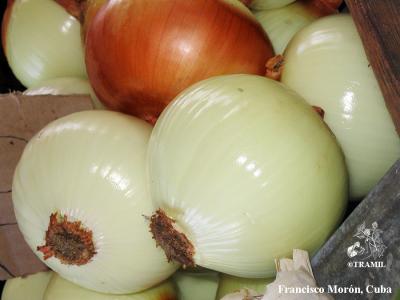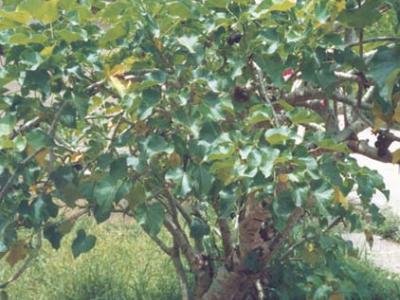(en territorios con usos significativos TRAMIL)
Santo Domingo:
- cebollín
Haití:
- zechalot
bulbo*, maceración en agua, aplicación local2
*la variedad utilizada es A. var. aggregatum G. Don
De acuerdo con la información disponible:
El uso para neumopatía se clasifica como REC con base en el empleo significativo tradicional documentado en las encuestas TRAMIL y la información científica publicada.
En caso que se observe deterioro del paciente o que los síntomas persistan por más de 7 días, debe buscar la atención médica.
Por el riesgo de la neumopatía para la salud, se recomienda una valoración médica inicial. El uso de este recurso debe ser considerado como complementario al tratamiento médico, salvo contraindicación.
Se ha recomendado que la cebolla (Allium cepa) solo se utilice en cantidades limitadas porque contiene alilsulfóxidos y otros sulfóxidos relacionados que inhiben las enzimas con grupos tiol4.
El uso para sapito (candidiasis bucal) se clasifica como REC con base en el empleo significativo tradicional documentado en las encuestas TRAMIL y la información científica publicada.
Toda aplicación tópica debe seguir estrictas medidas higiénicas para impedir la contaminación o la infección sobreañadida.
No usar durante el embarazo, la lactancia ni en niños menores de 3 años.
Los bulbos de Allium cepa var. cepa y Allium cepa var. aggregatum constituyen un alimento de consumo humano extendido.
Contra neumopatía:
picar 1 a 3 bulbos, machacarlos en un mortero y exprimir en un paño o dando vueltas con una cucharita en un colador de mano. Mezclar 1-2 cucharadas (15 a 30 mililitros) del zumo con miel de abejas. Tomar en ayunas diariamente durante 3 semanas.
Contra resfriado, gripe:
preparar una decocción con 1 bulbo en 2 tazas (½ litro) de agua, hervir por 10 minutos en recipiente tapado. Dejar enfriar, colar (filtrar) y beber 1 taza 3 veces al día.
O preparar un “jarabe” cortando 1 bulbo, mezclar con 3 cucharadas de azúcar, dejar descansar varias horas, filtrar con un paño o un colador fino y tomar una cucharada 3 veces al día hasta desaparición de los síntomas.
Contra sapito (candidiasis bucal):
picar 100 gramos del bulbo y agregarlos a 2 tazas (½ litro) de agua hervida, dejar macerar durante 12 horas y aplicar con gotero o cucharita 5 mililitros, 3 veces al día durante 5 días.
Ninguna preparación debe guardarse por más de 24 horas, ni fuera de refrigeración.
1 GERMOSÉN-ROBINEAU L, GERÓNIMO M, AMPARO C, 1984
Encuesta TRAMIL. enda-caribe, Santo Domingo, Rep. Dominicana.
2 WENIGER B, ROUZIER M, 1986
Enquête TRAMIL. Service Oecuménique d'Entraide SOE, Port au Prince, Haïti.
3 BOULOGNE I, 2009
Enquête TRAMIL, (Terre-de-Bas et Terre-de-Haut) Les Saintes, UAG, Guadeloupe (FWI).
4 AUGUST KT, 1996
Therapeutic values of onion (Allium cepa L.) and garlic (Allium sativum L.). Indian J of Experimental Biology 34(7):634-640.
5 BLOCK E, NAGANATHAN S, PUTMAN D, ZHAO SH, 1992
Allium chemistry: hplc analysis of thiosulfinates from onion, garlic, wild garlic (ramsoms), leek, scallion, shallot, elephant (great-headed) garlic, chive, and Chinese chive. Uniquely high allyl to methyl ratios in some garlic samples. J Agr Food Chem 40(12):2418-2430.
6 WU JB, CHENG YD, HUANG SC, CHANG KH, HSIEH MT, 1992
Quantitative determination of active compounds in Allium genus (Liliaceae) by hplc. China Med Coll J 1(2):123-128.
7 TOKITOMO Y, KOBAYASHI A, 1992
Isolation of the volatile components of fresh onion by thermal desorption cold trap capillary gas chromatography. Biosci Biotech Biochem 56(11):1865-1866.
8 DONNER H, GAO L, MAZZA G, 1997
Separation and characterization of simple and malonylated anthocyanins in red onions, Allium cepa L. Food Res Int 30(8):637-643.
9 FULEKI T, 1969
The anthocyanins of strawberry, rhubarb, radish and onion. J Food Sci 34(4):365-369.
10 PATIL BS, PIKE LM, YOO KS, 1995
Variation in the quercetin content in different colored onions (Allium cepa L.). J Amer Soc Hort Sci 120(6):909-913.
11 SHAMS-GHAHFAROKHI M, SHOKOOHAMIRI MR, AMIRRAJAB N, MOGHADASI B, GHAJARI A, ZEINI F, SADEGHI G, RAZZAGHI-ABYANEH M, 2006
In vitro antifungal activities of Allium cepa, Allium sativum and ketoconazole against some pathogenic yeasts and dermatophytes. Fitoterapia 77:321–323.
12 SRINIVASAN D, NATHAN S, SURESH T, PERUMALSAMY PL, 2001
Antimicrobial activity of certain Indian medicinal plants used in folkloric medicine. J Ethnopharmacol 74(3):217-220.
13 SHARMA KC, SHANMUGASUNDRAM SSK, 1979
Allium cepa as an antiasthmatic. RRL Jammu Newsletter 6(2):8.
14 DORSCH W, ETTL M, HEIN G, SCHEFTNER P, WEBER J, BAYER T, WAGNER H, 1987
Antiasthmatic effects of onion. Inhibition of platelet-activating factor-induced bronchial obstruction by onion oils. Int Arch Allergy Appl Immunol 82(3/4):535-536.
15 DORSCH W, ADAM O, WEBER J, ZIEGELTRUM T, 1985
Antiasthmatic effects of onion extracts -detection of benzyl- and other isothiocyanates (mustard oil) as antiasthmatic compounds of plant origin. Eur J Pharmacol 107(1):17-24.
16 DORSCH W, WAGNER H, 1991
New antiasthmatic drugs from traditional medicine? Int Arch Allergy Appl Immunol 94(1/2):262-265.
17 ROCKWELL P, RAW I, 1979
A mutagenic screening of various herbs spices and food additives. Nutrition and Cancer 1(4):10-16.
18 MAHMOUD II, ALKOFANI AS, ABDELAZIZ AA, 1992
Mutagenic and toxic activities of several spices and some Jordanian medicinal plants. Int J Pharmacog 30(2):81-85.
19 THOMSON M, ALNAQEEB MA, BORDIA T, AL-HASSAN JM, AFZAL M, ALI M, 1998
Effects of aqueous extract of onion on the liver and lung of rats. J Ethnopharmacol 61(2):91-99.
20 VERHOEFF J, HAJER R, VAN DEN INGH TS, 1985
Onion poisoning of young cattle. Vet Rec 117(19):497-498.
21 BEATTY ER, O'REILLY JD, ENGLAND TG, MCANLIS GT, YOUNG IS, GEISSLER CA, SANDERS TA, WISEMAN H, 2000
Effect of dietary quercetin on oxidative DNA damage in healthy human subjects. Br J Nutr 84(6):919-925.
22 GRUENWALD J, BRENDLER T, JAENICKE C, 2004
Physicians’ Desk Reference for Herbal Medicines, Third Edition. Montvale, NJ, USA: Thomson Healthcare, Inc. 988pp.
23 VALDIVIESO R, SUBIZA J, VARELA-LOSADA S, SUBIZA JL, NARGANES MJ, MARTINEZ-COCERA C, CABRERA M, 1994
Bronchial asthma, rhinoconjunctivitis, and contact dermatitis caused by onion. J of Allergy Clin Immunol 94(5):928-930.



